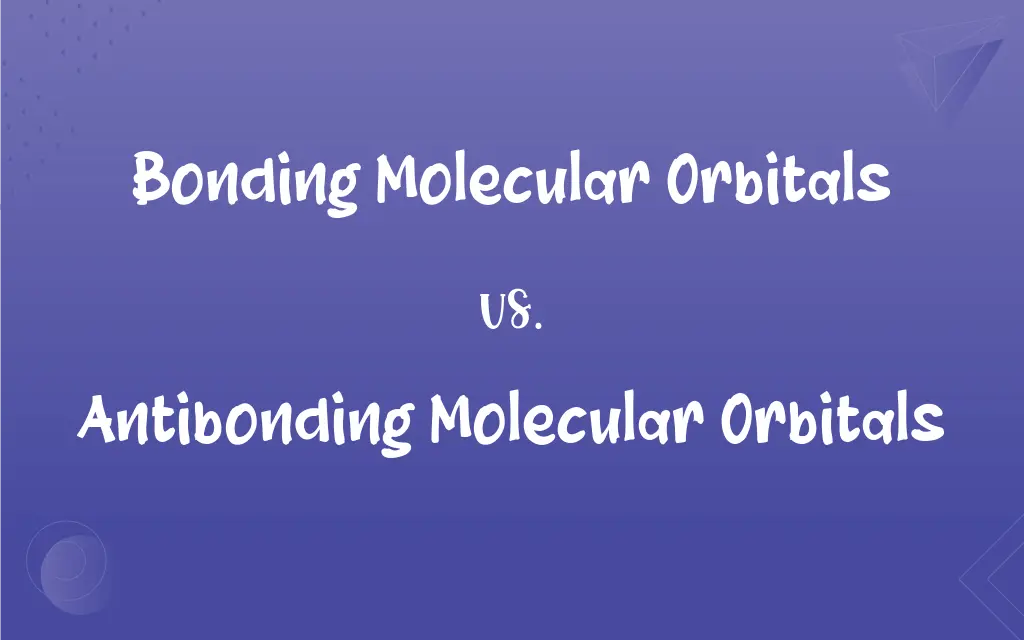Bonding Molecular Orbitals vs. Antibonding Molecular Orbitals: What's the Difference?
Edited by Aimie Carlson || By Janet White || Published on July 10, 2024
Bonding molecular orbitals stabilize molecules by allowing electrons to be shared between atoms, whereas antibonding molecular orbitals destabilize them by reducing electron density between atomic nuclei.

Key Differences
Bonding molecular orbitals (MOs) are formed when atomic orbitals overlap constructively, leading to an increase in electron density between the nuclei of bonding atoms. This constructive interference results in a lower energy state than the original atomic orbitals, contributing to the stability and formation of a chemical bond. Antibonding molecular orbitals, on the other hand, are the result of destructive overlap between atomic orbitals, which leads to a decrease in electron density between the nuclei and an increase in energy compared to the original atomic orbitals. Antibonding MOs can weaken or prevent the formation of a chemical bond if occupied by electrons.
Electrons in bonding molecular orbitals serve to hold atoms together, effectively lowering the energy of the molecule and making it more stable. In contrast, electrons in antibonding molecular orbitals have the opposite effect; they contain enough energy to potentially break bonds and increase the molecule's energy, making it less stable. The presence of electrons in antibonding orbitals is directly related to the bond order and stability of a molecule, with more electrons in these orbitals leading to weaker bonds.
The distribution of electrons between bonding and antibonding molecular orbitals is crucial for determining the bond order and molecular stability. A higher number of electrons in bonding orbitals compared to antibonding orbitals signifies a stable bond formation, whereas a higher number of electrons in antibonding orbitals can lead to bond dissociation. This electron distribution is described by molecular orbital theory, which provides a more accurate depiction of electron distribution in molecules than simple Lewis structures or valence bond theory.
Bonding MOs are typically lower in energy and closer to the nuclei they bond, which is why they contribute to the stability of a molecule. The energy difference between the bonding and antibonding orbitals (the energy gap) can also affect the chemical properties of the molecule, including its reactivity and color. Antibonding MOs, being higher in energy, are often unoccupied in stable molecules but can be populated in excited states or during chemical reactions, influencing the molecule's behavior under various conditions.
Both types of molecular orbitals are fundamental to understanding chemical bonding and the properties of molecules, their roles are distinctly opposite. Bonding orbitals are essential for the formation and stability of chemical bonds, whereas antibonding orbitals provide a mechanism for bond breaking and the potential instability of molecules, playing a critical role in chemical reactions and excited states.
ADVERTISEMENT
Comparison Chart
Energy Relative to Atomic Orbitals
Lower
Higher
Electron Density
Increased between nuclei
Decreased between nuclei
Effect on Molecular Stability
Stabilize molecules
Destabilize molecules
Role in Chemical Bonding
Facilitate bond formation
Prevent or weaken bond formation
Occupancy in Stable Molecules
Usually filled with electrons
Usually empty or less filled
ADVERTISEMENT
Bonding Molecular Orbitals and Antibonding Molecular Orbitals Definitions
Bonding Molecular Orbitals
Low-energy states enhancing molecular stability.
Electrons in bonding orbitals are responsible for water's stable structure.
Antibonding Molecular Orbitals
Orbitals that increase molecular energy and can destabilize bonds.
Electrons in antibonding orbitals can weaken the bond in H2+.
Bonding Molecular Orbitals
Orbitals that lower the energy of a molecule by electron sharing.
The sigma bonding molecular orbital in H2 stabilizes the molecule.
Antibonding Molecular Orbitals
Result of destructive orbital overlap.
Antibonding molecular orbitals in oxygen molecules make them reactive.
Bonding Molecular Orbitals
Constructive overlap of atomic orbitals.
Bonding molecular orbitals contribute to the formation of O2's double bond.
Antibonding Molecular Orbitals
High-energy states potentially leading to bond dissociation.
Occupancy in antibonding orbitals is critical in determining molecular ion stability.
Bonding Molecular Orbitals
Electron density increasers between atomic nuclei.
The bonding orbitals in methane ensure a tetrahedral shape.
Antibonding Molecular Orbitals
Detractors from molecular stability when occupied.
Filling antibonding orbitals in diatomic nitrogen would weaken its triple bond.
Bonding Molecular Orbitals
Stabilizers of molecular structure through electron sharing.
The bonding orbital in nitrogen molecules strengthens the triple bond.
Antibonding Molecular Orbitals
Reducers of electron density between atoms.
Antibonding orbitals contribute to the instability of certain chemical intermediates.
FAQs
Can a molecule exist without antibonding orbitals?
No, formation of bonding orbitals is accompanied by the formation of antibonding orbitals.
Why are antibonding orbitals higher in energy?
Due to destructive interference, reducing electron density between nuclei.
What defines a bonding molecular orbital?
It's formed by the constructive overlap of atomic orbitals, lowering energy.
What is an antibonding molecular orbital?
Formed by destructive overlap, it increases energy and can destabilize bonds.
Can bonding orbitals exist without electrons?
Theoretically, yes, but such orbitals typically contain electrons in stable molecules.
How does the presence of electrons in antibonding orbitals affect a molecule?
It can weaken bonds, making the molecule less stable or reactive.
How are bonding and antibonding orbitals represented in molecular orbital theory?
As diagrams showing their relative energy levels and electron occupancy.
What determines whether an orbital is bonding or antibonding?
The phase relation and spatial orientation of the overlapping atomic orbitals.
How do bonding orbitals contribute to stability?
By increasing electron density between nuclei, thus lowering the molecule's energy.
What role do electrons in bonding orbitals play?
They stabilize the molecule by participating in chemical bonding.
What's the significance of the energy gap between bonding and antibonding orbitals?
It determines the stability and reactivity of the molecule.
How do bonding and antibonding orbitals affect bond order?
Bond order is determined by subtracting the number of electrons in antibonding orbitals from those in bonding orbitals.
What is a pi antibonding orbital?
A type of antibonding orbital formed by side-to-side overlap of atomic orbitals.
Are antibonding orbitals always occupied in molecules?
No, they may remain unoccupied, especially in stable, low-energy molecules.
Can a single electron occupy a bonding molecular orbital?
Yes, electrons can singly occupy molecular orbitals according to Hund's rule.
What is the role of molecular orbital theory in chemistry?
It provides a detailed explanation of chemical bonding, stability, and molecular structure.
Can the number of bonding and antibonding orbitals vary in a molecule?
The number of bonding and antibonding orbitals created from a set of atomic orbitals is always equal, but their occupancy by electrons can vary.
How do antibonding orbitals influence chemical reactions?
They can determine reaction pathways by affecting molecular stability and reactivity.
What happens when antibonding orbitals are fully occupied?
The molecule becomes highly unstable or may not form at all.
What is a sigma bonding orbital?
A type of bonding orbital formed by end-to-end overlap of atomic orbitals.
About Author
Written by
Janet WhiteJanet White has been an esteemed writer and blogger for Difference Wiki. Holding a Master's degree in Science and Medical Journalism from the prestigious Boston University, she has consistently demonstrated her expertise and passion for her field. When she's not immersed in her work, Janet relishes her time exercising, delving into a good book, and cherishing moments with friends and family.
Edited by
Aimie CarlsonAimie Carlson, holding a master's degree in English literature, is a fervent English language enthusiast. She lends her writing talents to Difference Wiki, a prominent website that specializes in comparisons, offering readers insightful analyses that both captivate and inform.






































































